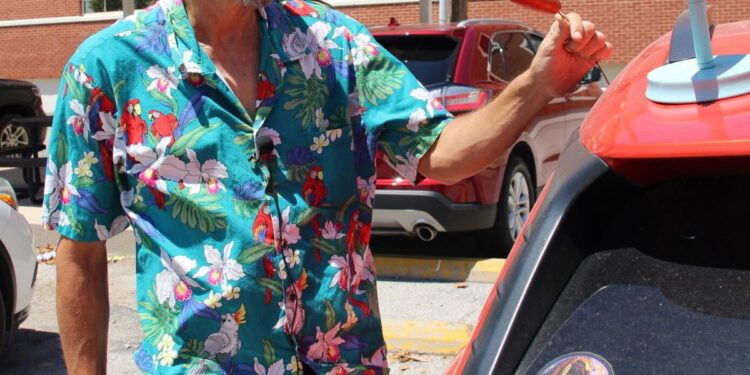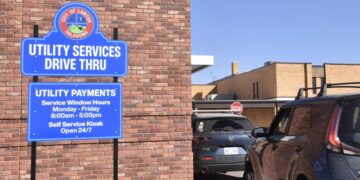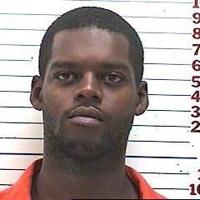With Lawton temperatures boiling over 100 degrees for more days in a row than most people care to count, The Constitution decided the time was right to conduct a science experiment on Thursday.
The goal: to find out how long it takes to cook hot links under the sun while impaled on a car antenna.
We’ll call this the commando cooking experiment.
After an hour of unobstructed ultraviolet rays raining down while conducting a scientifically unscientific experiment, one adage can be added to the book of colloquialism: A watched wiener never pops … at least, not really. But after 47 minutes in the sun, hot links skewered on a makeshift antenna begin to split and sweat.
Inspired by a conversation during a weekly staff meeting the day before, the reporter brought a package of hot links filled with American cheese from the store Thursday morning. If only a meat thermometer were remembered, this would be a much more scientific experience.
By 10:20 a.m., the temperature was already 95 degrees and rising. The meat thermometer probably wouldn’t matter by 3 p.m.
Lab assistant and intern Johannes Becht’s car, the only older model car with an actual wire antenna in the paper’s parking lot, was in the shop causing for an alteration in experiment plans. The reporter made due with a wire coat hanger stripped and pulled into shape to fit in his car door. The intern would serve as Igor to the reporter’s Dr. Frank N. Furter.
While waiting for temperatures to rise, one hot link was pulled out of its package and kept deskside atop a paper towel clearly marked “Science.” It served as a hopeful deterrent for any other hungry newsroom denizens. The rest of the package was refrigerated for the upcoming experiment.
In the name of science, the reporter heated a cold hot link for 36 seconds in the break room microwave to get a baseline. It was enough time for the hot link’s casing to stretch and burst. Edible, it wasn’t exactly “straight from the grill.”
At 2 p.m., the outdoor temperature was 106 degrees and set up for the experiment began from the concrete parking lot. By 2:15 p.m., three hot links were lined on the makeshift antenna. On the bottom was the room temperature link. The middle and top links were refrigerated. A three times enlarging magnifying mirror was placed on the car’s roof and aimed for the top link to see if cooking would accelerate.
Within a minute, the top link began to sweat some from the opening where the wire had run through its meat and casing. Soon after, the same effect happened with the other two. In less than five minutes, all through would have small amounts of cheesy goodness bubbling from the exit points of the wire.
There was hope it would be a quick experiment. Hopes would soon melt away under the August sky.
Reporter and intern stood in the sun for a long time with cameras in hand, awaiting that much hoped for “pop” that signals something’s cooking.
Standing in the sweltering sun, focused and fixated on the links, with eyes scanning for pulsing or some sign of impending eruption, it’s easy to see how a mirage works. Eyes lied that there was more to the moment before realizing a breeze from the south was causing the wieners to weigh down the wire and bob lightly and sway.
You begin to understand how scientists become mad scientists as the process played out.
Adjusting the mirror, moving it by hand closer and around the intended hot link proved unworthy of the effort. After a half hour and the wire beginning to droop from supporting the weight and spin away from the car, a game plan change was made.
The mirror’s aim was changed to focus on the once room-temperature hot link, its beam focused on a small spot where a rivulet of cheese began to peek from a small slit in the casing. Standing in spot holding the focus like a laser for a few minutes felt an infernal eternity. At least sweat was still pouring. When that stops, watch out for heat stroke, at least for the reporter.
Conceding that standing there, willing the wieners to bubble and blister was a frank exercise in futility, reporter and intern sat out a good 12 minutes under the shade of a canopy. It was time to let the sun do its work to the untended links.
With 15 minutes to go, a return to check on the links’ condition showed much in common between the experiment and those conducting it: all exposed meats were sweating steadily.
Watching the stopwatch count down to five minutes to go, time flew while standing still just the same.
“5, 4, 3, 2, 1 ….”
The hour had passed, and hot links collected and plated. It was time to taste the fruits of the folly.
The top dog, so to speak, was cooked. Warmed more than the microwaved test subject and plumped from the pressure, its spices were enhanced from the cooking, the cheese inside was soft if not completely liquid. The second link, although untouched by the mirror’s rays, was cooked marginally less well done but still, technically cooked.
The one that came closest to the goal was the hot link left untended to reach room temperature before the experiment. Joined with the final half hour’s magnified sunlight from the mirror, its casing was close to being overcooked. Inside, it’s pork, chicken and beef byproduct with spices and cheese intermingled had hit the mark. This one was cooked and reasonably well at that. It was, at least, well worth the effort. That thought could also be attributed to a heat overdose.
The final test. The intern took his bite. “It’s too spicy,” he said.
“Good enough,” the reporter replied.
So, while the heat may not hit the mark as the ideal cooking engine, if you’re ever in a survival moment and desperately want to cook your hot dog, hot link, smoked sausage or what have you, it’ll get the job done, albeit slowly.
However, for this reporter, the grill still wins the day as the way to go for those in the know.
And now you know.
Want to reach a local audience and grow your business?
Our website is the perfect platform to connect with engaged readers in your local area.
Whether you're looking for banner ads, sponsored content, or custom promotions, we can tailor a package to meet your needs.
Contact us today to learn more about advertising opportunities!
CONTACT US NOW





